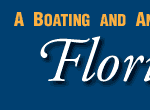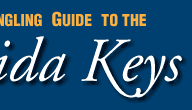CONTACT US:
Florida Fish and Wildlife
Conservation Commission
Fish and Wildlife
Research Institute
100 Eighth Avenue SE
St. Petersburg, Florida 33701
727-896-8626
|
|
|
Mote Marine Laboratory
Tropical Research Laboratory
24244 Overseas Hwy.
Summerland Key, FL 33042
305-745-2729
|
|
|

|
|
This project was funded in part by a grant awarded from Mote Marine Laboratory's Protect Our Reefs Grants Program, which is funded by proceeds from the sale of the Protect Our Reefs specialty license plate. Learn more at .
|
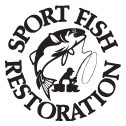
|
|
Additional funding for this project was obtained through the Federal Aid in Sport Fish Restoration Fund.
|
|
|

|
SPINY LOBSTERS
Commonly referred to as the Florida spiny lobster, the Caribbean spiny lobster inhabits tropical and subtropical waters of the Atlantic Ocean, Caribbean Sea, and Gulf of Mexico. Spiny lobsters get their name from the forward-pointing spines that cover their bodies. They lack large claws that are associated with the American lobster found in New England and Canada but have long-spine covered antennae to defend themselves from predators. Spiny lobsters are well adapted to their environment. They have built in navigation system and have a highly developed sense of smell and taste, but they sense these chemicals with the smaller antennae-like structures, antennules and the hairs, setae which cover the sharp tips of their 10 legs.
Lobsters are nocturnal. During daylight hours they are usually in holes and crevices of reefs or other areas providing shelter. They emerging a couple of hours after dark to forage for food. Lobsters are predators not scavengers. Their diet consists mostly of live snails, clams, crabs, and urchins. The lobsters return to the safety of their dens several hours before sunrise. Spiny lobsters are a favorite Florida seafood and support a valuable fishery, but they are also an important part of the ecosystem and are both predator and prey to many other animals.
|
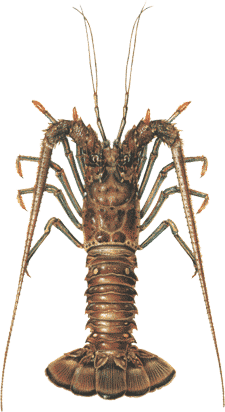
© Diane Rome Peebles
|
Lobsters are a regulated species in Florida waters. A fishing license and Spiny lobster permit are required to harvest lobsters. For more information about fishing for lobsters in the Keys, visit FWC's Spiny Lobster Web page.
More information about spiny lobsters can be found in FWC's Spiny Lobster Sea Stat brochure (PDF, 667 KB).
|
QUEEN CONCH
The queen conch is a large, marine, gastropod mollusk. Queen conchs have a spiral-shaped shell with a glossy pink or orange interior. Queen conchs achieve full size at about 3-5 years of age, growing to a maximum of about 12 inches (30.4 cm) long and weighing about 5 pounds (2.3 kg). The queen conch is a long-lived species, generally reaching 20-30 years old; however, the lifespan has been estimated as up to 40 years. The queen conch lives in sand, seagrass bed, and coral reef habitats. It is found in warm, shallow water and is generally not found deeper than 70 feet. The queen conch is found throughout the Caribbean Sea and Gulf of Mexico, and ranges as far north as Bermuda and as far south as Brazil. Once harvested for its tasty meat and beautiful shell, the queen conch became a protected species and is now protected from harvest in U. S. waters and efforts are being directed toward replenishing native populations.
|
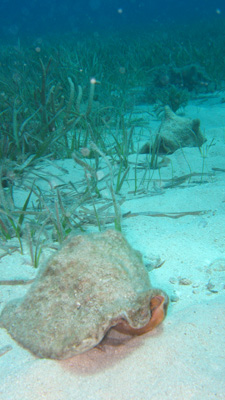
|
More information about queen conch can be found in FWC's Queen Conch Sea Stat brochure (PDF, 200 KB).
|
KEY DEER
The key deer is a subspecies of the Virginia white-tailed deer. These deer inhabit Big Pine Key and various surrounding keys. The key deer is smallest of all white-tailed deer and is found nowhere else in the world. They stand 24 to 32 inches at the shoulder. Does weigh 45 to 65 pounds, while bucks weigh 55 to 80 pounds. Key deer feed on native plants such as red, black, and white mangroves; thatch palm berries; and over 160 other species of plants. Key deer can tolerate small amounts of salt in their water, but fresh water is essential for their survival.
The feeding of Key Deer, or any other animals in the Florida Keys National Wildlife Refuges, is illegal and can result in a fine.
|
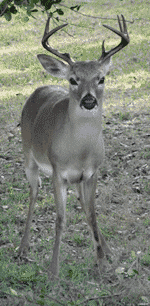
|
|
If you are out snorkeling, diving, fishing, paddling, or boating and see anything that may be unusual or out of the ordinary (including lionfish) in the waters around the Keys , please record the location, date, and time, and contact the Marine Ecosystem Event Response and Assessment (MEERA) project. They can be reached by phone (305-395-8730), e-mail, or online.
If you have any questions, comments, or suggestions about this Web site, please e-mail us at Boating_Guides@MyFWC.com.
Would you like to receive notices of changes to this Web site and the Boating and Angling Guides to the Upper, Middle, or Lower Keys? If so, please e-mail us and include SUBSCRIBE-KEYS in the subject line.
|
